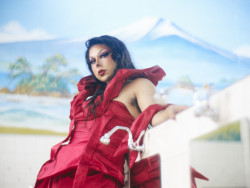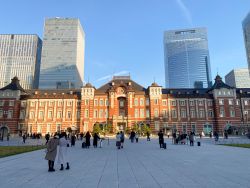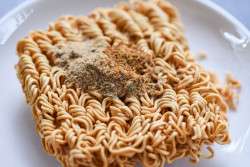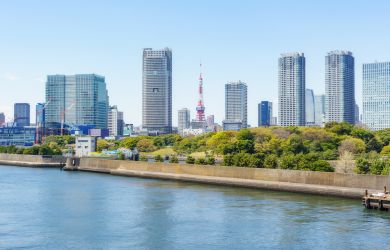
January 8, 2004
Up Where We Belong
As the skiing and snowboarding season comes into full swing, a handful of pros provide tips on where to travel this winter. Carlo Niederberger reports.
By Metropolis
Originally published on metropolis.co.jp on January 2004

Of all the world-class ski resorts he’s carved through over the years, Hiroomi Takizawa, Crystal Trophy winner of last season’s FIS World Cup skicross championship, likes nowhere better than Niseko, one of Hokkaido’s top draws for powder-hungry, off-piste aficionados.
“The snow conditions at Niseko are unlike any in Japan. It’s real powder. Not many places in the world can offer such superb conditions as well as the many bars serving good sake, great people, pleasant atmosphere and onsen,” explains the 30-year-old, swigging beer at a Nakameguro izakaya on a recent whirlwind trip to Japan in between training sessions in France and Italy. “I go there every year even if it means paying out of my own pocket. I like it that much.”
Takizawa, whose sport involves four or six skiers simultaneously racing around gates and over obstacles to the finish line, is one of a growing number of professional winter sports stars hoisting the hinomaru at podiums overseas. But for many, fame and fortune haven’t clouded fond memories of Japan’s own snow-capped mountains. Home to 775 ski areas, according to the Japan Tourism Association, this island nation is a prime training ground for future pros as well as a sought-after spot for foreign skiers and snowboarders in search of that perfect powder.

Breaking through backcountry snow at Niseko-Hirafu
Niseko-Hirafu, Niseko’s main terrain made up of sub-resorts Kogen, Alpen and Hanazono, is Japan’s undisputed Mecca of powder snow where out-of-bounds runs have in recent years been extensively cultivated by Japanese as well as foreign visitors, while resort officials look the other way. The “Niseko local rule” states every skier or snowboarder is free to venture into backcountry territory at their own risk, as long as they stay away from Haru no Taki, an area especially prone to avalanches that most recently killed a person five years ago.
While not the vastest of resorts, Niseko-Hirafu, whose season began November 29, operates 18 lifts including a gondola, and offers 34 runs, the steepest of which lies on a 37-degree gradient and the longest of which measures 5,600 meters. Most are lit up until 9pm every day. Last season, the skier-snowboarder ratio was a reported 6-4, and those in the minority are allowed exclusive access to a 100m half-pipe and, with less equipment, an upper hand in reaching the abundant powder snow.
“There is nowhere else that I’ve experienced that has the same amount of consistent powder snow coming down,” says Ben Kerr, 33, a native of Sydney, Australia who co-runs local tour operator Niseko Powder Connection and is now in his eighth winter at Niseko. An avid snowboarder who switched over from skiing years ago, Kerr contends that the amount of “lift-accessible powder,” in Niseko is huge, and skiers and snowboarders can find plenty of powder within resort limits and on tree runs that travel in between each trail, since much of the resort isn’t groomed. “If you then want to walk, go backcountry or to the peak, it just gets bigger and bigger.”
But Kerr is also known to venture beyond his adopted backyard and rates Furano as another Hokkaido hot spot. Located roughly between Sapporo and Asahikawa, the 23-course, 13-lift resort split into two zones, Furano and Kitanomine, receives considerably less publicity than Niseko, despite having hosted ten FIS Alpine World Cup races and having two Prince Hotel complexes planted at the base of the mountain.
While novice and intermediate skiers find themselves at home on the Kitanomine side’s abundant practice runs, which offer an excellent grooming ground for tackling the steeper slopes up top, Furano-side skiers and snowboarders confront narrower channels through the forest with gradients as steep as 34 degrees, and a 600m-long attraction area made of jumps, table tops, banks, rails and a cross course.
“On its day,” Kerr says, “Furano can be more interesting than Niseko. It’s a great resort.”

Niseko's east face
Another pro with a penchant for the mountains of Hokkaido is Gota Miura, 33, who recently made headlines when he accompanied his 70-year-old father, Yuichiro, on his record-breaking conquest of Mount Everest. Free-style skiing fans may remember the younger Miura from the 1998 Nagano Olympics, when the mogulist finished a disappointing 13th before his home crowd in the first-ever Olympic competition of its kind. Nowadays, in between a long list of projects that includes a ski training program for the elderly and plans to climb the peaks of Mount McKinley in 2004 and Mount Everest again-this time from the Tibet side-in 2006 with his father, Miura is an instructor on the slopes of Sapporo Teine-Highland Ski Area.
“Teine-Highland has an expert course called the North Wall (Kita-Kabe) where skiers plow through trees at a gradient of nearly 40 degrees, and there are also courses laid out for everyone from beginners to advanced skiers, so it’s a really entertaining ski resort,” says the former Olympian. Having nurtured no less than four athletes who have made it to the quadrennial competitions, including Tae Satoya, gold medalist at Salt Lake City, Teine-Highland is a true testing ground for those who want to refine their skills, says Miura. It’s also the resort closest to the city of Sapporo, and yet offers magnificent slopes.
Six lifts, including a ropeway, combine for an upward traffic of 6,960 skiers and snowboarders per hour, and Teine-Highland’s seven runs include the 700m slalom course used during the 1972 Sapporo Olympics. Snowboarders also have access to a board park fitted with a series of professionally built waves, table tops, hand rails and a box and S-rail each across two runs, of which one remains lit after dark.
From mid-December to early April, when the resort closes, Teine-Highland is blessed with fine, light snow resulting from breezes blowing from the Sea of Japan, which deposit salt particles into the atmosphere that then aerate the snowflakes falling over the region. “With 92 percent powder snow, you can ski in genuinely good conditions, given its proximity to Sapporo,” notes Miura, who himself grew up on these slopes. “Although we instruct in ways that are a little different, like taking kids on backcountry runs and jumps, it’s an ideal environment to teach them the joy of skiing.”

Speeding down at Shiga-Kogen
Kenji Narita, 29, currently works as a snowboarding advisor at the Omiya branch of Murasaki Sports, a well-known distributor of extreme sporting goods, and on his days off during the winter, often snowboards at the Asagai Snowboard Park in Niigata. A park riding expert whose best performance was a fourth place finish on the half-pipe at the JSBA All-Japan Championships, the Saitama native is one of many who rate Asagai highly for its attractions, stretching from a competition-size 110m half pipe to kickers, boxes, mounds, a variety of rails and a table top.
“They’re built so well that you don’t hurt yourself on them,” Narita says, adding, “When other resorts in the Yuzawa area deteriorate in condition later in the season, Asagai and Naeba still have good snow. The board runs well on the surface, allowing you to have control over the speed at which you hit the items, and the softer snow in late February makes it easier to challenge difficult moves.”
Another area Narita recommends around Yuzawa is Ishiuchi Maruyama, a mammoth, 28-lift resort featuring the “Masterpiece Terrain Park,” an obstacle run open to both skiers and snowboarders and site of the 2004 Japan Open (snowboarding) to take place February 25-29.
Yoshiyuki Matsumoto, 33, is another from the pool of pros who advise eager Tokyo shoppers purchasing or servicing equipment in between training and competitions during the season. The boardercross master and former skier, ranked No. 1 two seasons ago in the PSA Japan Tour, works at Viento in Ochanomizu, a subsidiary of giant outdoor goods retailer Victoria, and often makes the trip up to Marunuma Kogen in Gunma Prefecture, his preferred snowboarding locale.
“It’s close by and the snow conditions are very good,” says the Tochigi native, who has competed professionally since 1998, “unlike Niigata where temperatures rarely fall, creating a lot of humidity and making the snow damp.” Marunuma, owing to its high elevation, enjoys dry, powdery snow, according to Matsumoto, who adds that, “snowboarding in such conditions allows you to make smooth progress in skill.”
Marunuma Kogen is a three-hour ride on two buses from the Joetsu Shinkansen’s Jomo-Kogen Station, and runs ten lifts, including a gondola that reaches the 2,000m summit from where the longest run measures 4,000m. As well as offering a park dotted with canyons, table tops and a quarter pipe, the ski and snowboard resort features several other facilities including communal sleeping quarters for early morning arrivals, a sizable onsen, a kids’ playroom and “rental houses” available for the daily rate of ¥18,000.
Akira Sasaki, 22, a Salt Lake City Olympian and one of Japan’s rising stars who won the silver in last season’s fifth FIS World Cup slalom final in Wengen, Switzerland, signed a contract in October tying him to Gala Yuzawa, one of Japan’s most convenient ski resorts. Gala skiers and snowboarders couldn’t have it easier-the Joetsu Shinkansen from Tokyo pulls right into the complex where they check in, suit up, and board the high-speed gondolas servicing the slopes. The Gala Yuzawa lobby also contains a café, an equipment rental booth, a gift and accessories store and an expansive onsen for a bone-soaking dip before catching the train home.
The 11-lift resort, which offers 15 diversified runs, saw more boarders than skiers last season, partly due to facilities including a 100m half-pipe, a quarter pipe, waves, table tops and kickers. But come April, Sasaki, who recently damaged knee ligaments during a practice session in Sšlden, Austria, is due to return to Gala to coach junior athletes and spearhead alpine-skiing promotional events including the Akira Sasaki Racing Seminar on April 10-11, giving skiers a chance to brush up on skills at the popular day-trip destination.

Hiroomi Takizawa is head and shoulders above the rest at Les Contamines, with the Crystal Trophy at his feet.
For a quick weekend getaway, several of the pros point to nearby Naeba, one of the perennial favorites for Tokyoites on a budget. “I travel there twice or three times a season, mainly for competitions,” says Takizawa, who in between races joins the locals on runs beneath the gondola path, an area known to have good powder. “Once you know the ins and outs, Naeba can be a lot of fun, and I plan to take advantage of it from now on,” adds the skicross champion. Like Takizawa, Narita is a fan of Naeba’s ledge in the shadows of the enclosed lifts. While off-piste runs in Naeba are prohibited, the snowboarder insists there is plenty of good powder on the trails up top.
The 28-lift, 27-trail resort, which also receives praise from Miura, is one of the largest in the country, and predictably is home to a sprawling Prince Hotel complex that places guests at a stone’s throw from the lifts, although nearby lodges and Japanese-style guest houses offer accommodation at lower rates. Skiers and snowboarders in the area also have the option of riding Dragondola, the world’s longest cable car that links Naeba with the neighboring three interconnected resorts of Kagura, Mitsumata and Tashiro.
Race fans, however, may want to stay put on February 21, when Takizawa visits Naeba for a skicross World Cup meet. He will be looking to repeat last year’s league victory in overall points, which included a gold-medal performance at Les Contamines in France. But given it’s one of only nine races, Takizawa smiles and says, “I must tackle each one carefully, and do my best at every race, because I want to win. Really.”
Photocredits: Niseko Powder Connection; Kokudo; Snow Japan; AFLO Foto Agency







